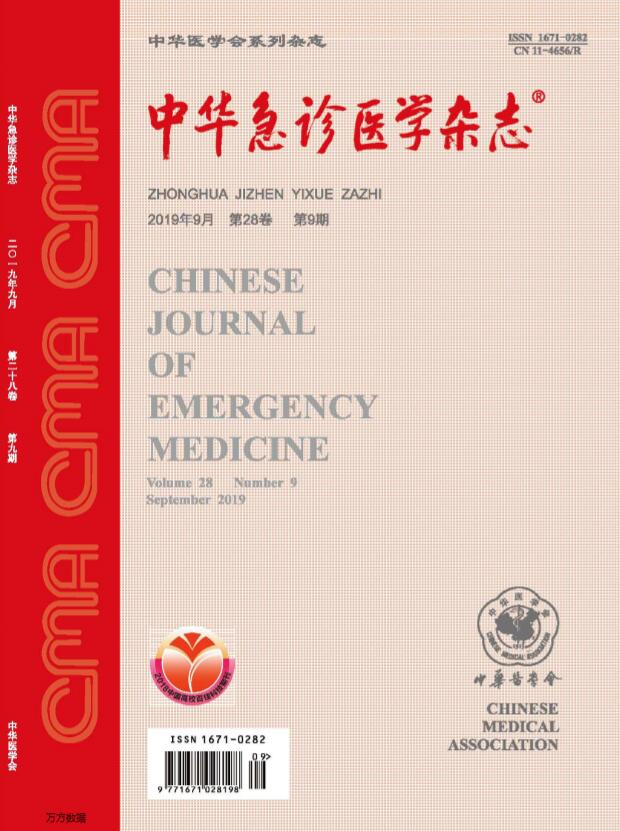Th1/Th2细胞因子对感染性儿童伴或不伴中性粒细胞减少症的预后价值
Q4 Nursing
引用次数: 0
摘要
目的探讨脓毒症患儿伴或不伴中性粒细胞减少症细胞因子的特点及预测预后的价值。方法138例败血症患儿按绝对中性粒细胞计数分为中性粒细胞减少组和非中性粒细胞减少组。脓毒症患儿根据循环功能和脏器灌注情况分为休克组和非休克组。分析两组患者c反应蛋白、降钙素原、细胞因子、PRISM-Ⅲ水平及临床结果。结果(1)共纳入138例败血症患儿,其中中性粒细胞减少64例,无中性粒细胞减少74例。中性粒细胞减少组PRISM-Ⅲ水平显著高于非中性粒细胞减少组(P=0.048)。两组死亡率无显著差异,但中性粒细胞减少组住院时间较非中性粒细胞减少组长。中性粒细胞减少组c反应蛋白、IL-6、IL-10水平显著高于非中性粒细胞减少组(P=0.001;P = 0.001;P = 0.032)。中性粒细胞减少组TNF-α水平明显低于非中性粒细胞减少组(P=0.032)。(2) 64例脓毒症合并中性粒细胞减少患儿中,23例合并休克。休克组PRISM-Ⅲ水平显著高于非休克组(P=0.001)。休克组死亡率(43.5%,10/23)显著高于非休克组(2.4%,1/41)(P=0.001)。休克组c反应蛋白、降钙素原、IL-6、IL-10、TNF-α明显高于非休克组(P=0.001;P = 0.001;P = 0.001;P = 0.005;P = 0.019)。IL-6的受试者工作特征曲线下面积为0.8(临界值315.38 pg/mL), IL-10的受试者工作特征曲线下面积为0.8(临界值45.18 pg/mL), TNF-α的受试者工作特征曲线下面积为0.85(临界值1.95 pg/mL)。(3) 74例无中性粒细胞减少的脓毒症患儿中,合并休克者19例。休克组PRISM-Ⅲ水平显著高于非休克组(P=0.022)。两组患者的死亡率差异无统计学意义(P=0.3)。休克组IL-10水平明显高于非休克组(P=0.015)。(4)42例脓毒症休克患儿中,合并中性粒细胞减少的患儿23例。中性粒细胞减少组PRISM-Ⅲ水平显著高于非中性粒细胞减少组(P=0.005)。两组患者死亡率差异无统计学意义(P=0.29)。中性粒细胞减少组c反应蛋白、降钙素原、IL-6、IL-10水平显著高于非中性粒细胞减少组(P=0.001;P = 0.001;P = 0.001;P = 0.035)。两组间TNF-α水平差异无统计学意义。(5)96例无脓毒症休克患儿中有41例合并中性粒细胞减少。中性粒细胞减少组与非中性粒细胞减少组间PRISM-Ⅲ水平无差异。中性粒细胞减少组的死亡率明显低于非中性粒细胞减少组(2.4% vs 20%, P=0.02)。中性粒细胞减少组c反应蛋白、IL-6水平显著高于非中性粒细胞减少组(P=0.005;P = 0.033)。TNF-α水平明显低于非中性粒细胞减少组(P=0.007)。结论与无中性粒细胞减少的患儿相比,脓毒症患儿合并中性粒细胞减少的住院时间更长,脓毒症患儿合并中性粒细胞减少的死亡率更高,IL-6、IL-10、TNF-α水平也显著升高。IL-6、IL-10、TNF-α水平对脓毒症患儿预后有预测作用。关键词:脓毒症;震惊;脓毒性休克;嗜中性白血球减少症;非嗜中性白血球减少症;细胞因子;孩子;预后本文章由计算机程序翻译,如有差异,请以英文原文为准。
The prognostic value of Th1/Th2 cytokines on septic children with or without neutropenia
Objective
To explore the characteristics and value for predicting prognosis of cytokines in septic children with or without neutropenia.
Methods
Totally 138 septic children were divided into the neutropenia and non-neutropenia groups according to absolute neutropenic count. Septic children were divided into the shock and non-shock groups according to circulation function and organ perfusion. The levels of C-reactive protein, procalcitonin, cytokines, PRISM-Ⅲ and clinical outcomes were analyzed between the relative groups.
Results
(1) Totally 138 septic children were recruited, 64 with neutropenia and 74 without neutropenia. The level of PRISM-Ⅲ of the neutropenia group was significantly higher than that of the non-neutropenia group (P=0.048).Mortality showed no significant difference between the two groups, but hospital stay in the neutropenia group was longer than that in the non-neutropenia group. The levels of C-reactive protein, IL-6, and IL-10 ihe neutropenia group were significantly higher than those of the non-neutropenia group (P=0.001; P=0.001; P=0.032). The level of TNF-α in the neutropenia group was significantly lower than that of the non-neutropenia group (P=0.032). (2)Among the 64 septic children with neutropenia, 23 were combined with shock. The PRISM-Ⅲ level of the shock group was significantly higher than that of the non-shock group (P=0.001). The mortality of the shock group (43.5%, 10/23) was significantly higher than the non-shock group (2.4%, 1/41) (P=0.001). C-reactive protein, procalcitonin, IL-6, IL-10 and TNF-α in the shock group elevated obviously than those in the non-shock group (P=0.001; P=0.001; P=0.001; P=0.005; P=0.019). The area under receiver operating characteristic curve was 0.8 for IL-6 (cut-off value 315.38 pg/mL), 0.8 for IL-10 (cut-off value 45.18 pg/mL), and 0.85 for TNF-α (cut-off value 1.95 pg/mL). (3) Among the 74 septic children without neutropenia, 19 were combined with shock. The PRISM-Ⅲ level of the shock group was significantly higher than that of the non-shock group (P=0.022).There was no significant difference of mortality between the two groups (P=0.3). IL-10 level in the shock group elevated obviously than that in the non-shock group (P=0.015).(4) Among the 42 children with sepsis shock, 23 were combined with neutropenia. The PRISM-Ⅲ level of the neutropenia group was significantly higher than that of the non-neutropenia group (P=0.005). There was no significant difference of mortality between the two groups (P=0.29). The levels of C-reactive protein, procalcitonin, IL-6 and IL-10 in the neutropenia group were significantly higher than those in the non-neutropenia group (P=0.001; P=0.001; P=0.001; P=0.035). There was no difference of TNF-α level between the two groups.(5) Among the 96 children without sepsis shock, 41 were combined with neutropenia. No difference of PRISM-Ⅲ level was observed between the neutropenia and non-neutropenia groups. The mortality of the neutropenia group was significantly lower than that in the non-neutropenia group (2.4% vs 20%, P=0.02). The levels of C-reactive protein and IL-6 in the neutropenia group were significantly higher than those in the non-neutropenia group (P=0.005; P=0.033). The TNF-α level was significantly lower than that in the non-neutropenia group (P=0.007).
Conclusions
Compared to children without neutropenia, septic children combined with neutropenia have longer hospital stay, and septic shock children combined with neutropenia have higher mortality, and levels of IL-6, IL-10 and TNF-α were also significantly increased. The levels of IL-6, IL-10 and TNF-α can help to predict prognosis of children with sepsis.
Key words:
Sepsis; Shock; Septic shock; Neutropenia; Non- neutropenia; Cytokine; Children; Prognosis
求助全文
通过发布文献求助,成功后即可免费获取论文全文。
去求助
来源期刊

中华急诊医学杂志
Nursing-Emergency Nursing
CiteScore
0.10
自引率
0.00%
发文量
8629
期刊介绍:
Chinese Journal of Emergency Medicine is the only national journal which represents the development of emergency medicine in China. The journal is supervised by China Association of Science and Technology, sponsored by Chinese Medical Association, and co-sponsored by Zhejiang University. The journal publishes original research articles dealing with all aspects of clinical practice and research in emergency medicine. The columns include Pre-Hospital Rescue, Emergency Care, Trauma, Resuscitation, Poisoning, Disaster Medicine, Continuing Education, etc. It has a wide coverage in China, and builds up communication with Hong Kong, Macao, Taiwan and international emergency medicine circles.
 求助内容:
求助内容: 应助结果提醒方式:
应助结果提醒方式:


